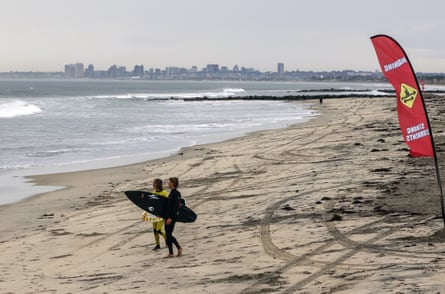A recent report revealed that the mixture of pathogens and toxic chemicals found in the Tijuana River, caused by raw sewage and runoff, is negatively affecting communities at the border of the United States and Mexico.
According to a report published by San Diego State University, a large amount of sewage containing harmful chemicals such as arsenic, viruses, bacteria, and parasites flows through the river, which travels from Mexico through California and eventually reaches the Pacific Ocean.
The scientists have described the situation as a “serious public health emergency.”
Wastewater entering the ocean has led to over 700 consecutive days of beach closures in San Diego county. However, the pollution is not only confined to the water. Harmful substances and microorganisms found in sewage have also been found in the surrounding air and soil, putting even those who live miles away from the water at risk.
For many years, communities on both sides of the border have been expressing concern about this pollution. They have reported a constant unpleasant odor in the air and advocated for improved sewage infrastructure. In recent years, unusually severe storms, worsened by the climate emergency, have added further strain to already struggling sewage systems and posed greater threats to public health.
According to Paula Stigler Granados, an associate professor at San Diego State University’s School of Public Health and the lead author of the paper, this is not a small amount of contamination but rather a significant amount that has persisted for a prolonged period.
The report confirms the long-held concerns and anxieties of Imperial Beach residents, a town located north of the border with Mexico, regarding the escalating sewage issue.
According to Paloma Aguirre, the mayor of Imperial Beach, the city is a prime example of environmental injustice.

A person who enjoys surfing and has been a strong supporter of protecting the coast, Aguirre dedicated almost twenty years to promoting ways to address the pollution in Imperial Beach before becoming the mayor in 2022.
She explained that the situation was made more complex by the fact that it involves both the US and Mexican governments due to the geographical location. In January, Mexico began constructing a new sewage treatment facility to replace the old one in Punta Bandera, which is located six miles from the border.
In 2020, the United States government allocated a $300 million budget to enhance a sanitation facility in San Ysidro, located north of the border. However, a memo obtained by the San Diego Union Tribune in the previous year disclosed that the plant was in poor condition and half of the funds would be necessary for upkeep of the current infrastructure.
Aguirre, along with other leaders and supporters in the community, have been advocating for an extra $310 million in federal funding to enhance the capacity for wastewater treatment. This request was included by Joe Biden in an urgent funding proposal in October, but it has not yet been authorized by Congress. Governor Gavin Newsom of California and Congressman Scott Peters, whose district borders Imperial Beach, have also emphasized the need for immediate action.
Ignore the advertisement for the newsletter.
after newsletter promotion
Aguirre stated that in the past year, this matter has received unprecedented levels of attention. However, he believes it is still not sufficient.
The purpose of this week’s report was to support the requests of officials for additional resources. Granados and her team examined over 60 studies and reports in order to provide an overview of the public health and environmental dangers posed by urban runoff and sewage in the area, at the behest of Peters and the Conrad Prebys Foundation, a charitable organization in the local community.
The report discusses various dangers associated with sewage overflows, such as the emergence of antibiotic resistant E coli and legionella strains. It also states that these overflows may reintroduce illnesses that have almost been eliminated in the US, like tuberculosis. Additionally, the sewage contains harmful substances like banned pesticides (such as DDT) and heavy metals, likely from industrial waste runoff that mixes into the river. Researchers noted that these pollutants can even become airborne from waves, spreading disease-causing agents and chemicals throughout the area.
The sewage is a serious threat to the nearby ecosystems. The scientists refer to a recent incident where bottlenose dolphins were beached in San Diego and it was discovered that they had died from sepsis due to a bacteria often spread through contact with feces or urine.
There is still a lot that is unknown by researchers regarding the crisis. This includes the impact of extended exposure to different pollutants, bacteria, and other harmful substances on people’s well-being. However, the researchers emphasized the need for immediate investments in infrastructure and public health resources.
According to Aguirre, living in this area has impacted everyone in some way. She herself has had to visit urgent care multiple times due to getting sick, such as contracting viral pharyngitis, from spending time near the water. This has unfortunately become a regular occurrence for us, but it should never be considered normal for anyone.
Source: theguardian.com

















